
The Metropolitan Museum of Art in New York City, colloquially "the Met", is the largest art museum in the Americas. In 2022 it welcomed 3,208,832 visitors, ranking it the third most visited U.S museum, and eighth on the list of most-visited art museums in the world. Its permanent collection contains over two million works, divided among 17 curatorial departments. The main building at 1000 Fifth Avenue, along the Museum Mile on the eastern edge of Central Park on Manhattan's Upper East Side, is by area one of the world's largest art museums. The first portion of the approximately 2-million-square-foot (190,000 m2) building was built in 1880. A much smaller second location, The Cloisters at Fort Tryon Park in Upper Manhattan, contains an extensive collection of art, architecture, and artifacts from medieval Europe.

Raffaello Sanzio da Urbino, now generally known in English as Raphael, was an Italian painter and architect of the High Renaissance. His work is admired for its clarity of form, ease of composition, and visual achievement of the Neoplatonic ideal of human grandeur. Together with Leonardo da Vinci and Michelangelo, he forms the traditional trinity of great masters of that period.

The Raphael Cartoons are seven large cartoons for tapestries, surviving from a set of ten cartoons, designed by the High Renaissance painter Raphael in 1515–16, commissioned by Pope Leo X for the Sistine Chapel in the Vatican Palace. The tapestries show scenes from the Gospels and Acts of the Apostles and are hung below the frescoes of the Life of Christ and the Life of Moses commissioned by Pope Sextus. The cartoons belong to the British Royal Collection but since 1865 are on loan to the Victoria and Albert Museum in London.
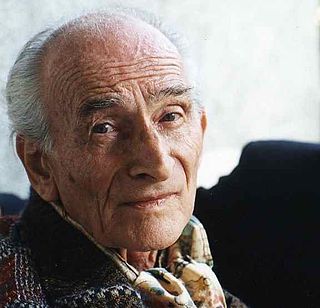
Balthasar Klossowskide Rola, known as Balthus, was a Polish-French modern artist. He is known for his erotically charged images of pubescent girls, but also for the refined, dreamlike quality of his imagery.

Madonna and Child was painted by one of the most influential artists of the late 13th and early 14th century, Duccio di Buoninsegna. This iconic image of the Madonna and Child, seen throughout the history of western art, holds significant value in terms of stylistic innovations of religious subject matter that would continue to evolve for centuries.

Marcantonio Raimondi, often called simply Marcantonio, was an Italian engraver, known for being the first important printmaker whose body of work consists largely of prints copying paintings. He is therefore a key figure in the rise of the reproductive print. He also systematized a technique of engraving that became dominant in Italy and elsewhere. His collaboration with Raphael greatly helped his career, and he continued to exploit Raphael's works after the painter's death in 1520, playing a large part in spreading High Renaissance styles across Europe. Much of the biographical information we have comes from his life, the only one of a printmaker, in Vasari's Lives of the Artists.

Jacopo Caraglio, Giovanni Jacopo Caraglio or Gian Giacomo Caraglio known also as Jacobus Parmensis and Jacobus Veronensis was an Italian engraver, goldsmith and medallist, born at Verona or Parma. His career falls easily into two rather different halves: he worked in Rome from 1526 or earlier as an engraver in collaboration with leading artists, and then in Venice, before moving to spend the rest of his life as a court goldsmith in Poland, where he died.
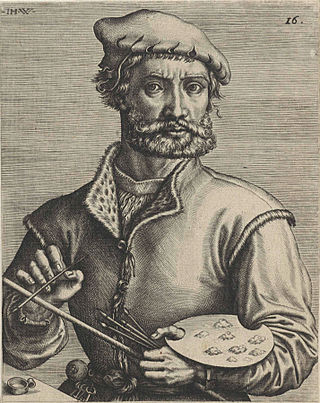
Pieter Coecke van Aelst or Pieter Coecke van Aelst the Elder was a Flemish painter, sculptor, architect, author and designer of woodcuts, goldsmith's work, stained glass and tapestries. His principal subjects were Christian religious themes. He worked in Antwerp and Brussels and was appointed court painter to Charles V, Holy Roman Emperor.

The Canigiani Holy Family or Canigiani Madonna is an oil-on-wood painting by the Italian High Renaissance artist Raphael, executed circa 1507–1508.

The Madonna and Child Enthroned with Saints, also known as the Colonna Altarpiece, is a painting by the Italian High Renaissance artist Raphael, executed c. 1503-1505. It is housed in the Metropolitan Museum of Art of New York City. It is the only altarpiece by Raphael in the United States.

The Madonna del Prato, formally Madonna with the Christ Child and Saint John the Baptist, is an oil on board painting by Raphael, created in 1506, now held in the Kunsthistorisches Museum in Vienna. It is also known as the Madonna del Belvedere after its long residence in the imperial collection in the Vienna Belvedere.

The portrait of a man in red chalk in the Royal Library of Turin is widely, though not universally, accepted as a self-portrait of Leonardo da Vinci. It is thought that Leonardo da Vinci drew this self-portrait at about the age of 60. The portrait has been extensively reproduced and has become an iconic representation of Leonardo as a polymath or "Renaissance Man". Despite this, some historians and scholars disagree as to the true identity of the sitter.

Ambrosius Benson was an Italian painter who became a part of the Northern Renaissance.

Tarquin and Lucretia is an oil painting by Titian completed in 1571, when the artist was in his eighties, for Philip II of Spain. It is signed, and considered to have been finished entirely by Titian himself. It is one of a series of great works from Titian's last years, but unlike some of these, is fully finished. It is now in the Fitzwilliam Museum in Cambridge, England.
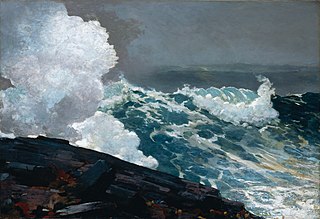
Northeaster is one of several paintings on marine subjects by the late-19th-century American painter Winslow Homer. Like The Fog Warning and Breezing Up, he created it during his time in Maine. It is on display in the Metropolitan Museum of Art in New York. Viewers are presented a struggle of elements between the sea and the rocky shore. Winslow Homer excelled in painting landscape paintings that depicted seascapes and mountain scenery.
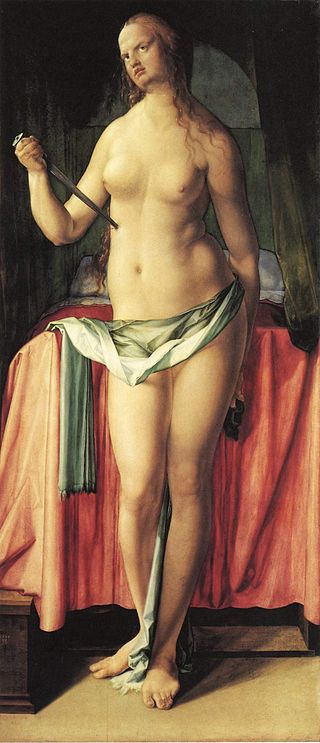
The Suicide of Lucretia is an oil on lime panel painting by Albrecht Dürer, signed and dated 1518, in the collection of the Alte Pinakothek, Munich. It shows the Ancient Romean heroine Lucretia, wife of Lucius Tarquinius Collatinus, in a tall and narrow framing, in the act of killing herself rather than face the shame of being raped by her cousin Sextus Tarquinius. Lucretia stands in front of a cramped and harshly lit room containing the bridal bed on which she was raped. She looks to the sky, as if asking the gods to witness her suicide. Her face betraying feelings of disgrace, as she stabs herself with a sword to the belly. The panel is Dürer's second treatment of Lucretia, following a very similar 1508 drawing. The earlier composition, drawn in ink with wash on paper, is in the Albertina museum, Vienna.

Lucretia is a 1666 history painting by the Dutch Golden Age painter Rembrandt Harmensz van Rijn in the collection of the Minneapolis Institute of Art. It is an oil painting on canvas that depicts a myth about a woman named Lucretia who lived during the ancient Roman eras. She committed suicide to defend her honor after being raped by an Etruscan king's son. For her self-sacrifice she is known as a heroine to the Romans, who celebrated the feminine ideals of virtue and chastity.
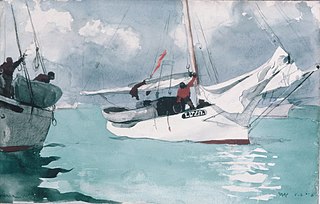
Fishing Boats, Key West is a 1903 watercolor and graphite drawing by Winslow Homer. It is in the collection of the Metropolitan Museum of Art.

Mother and Child (The Oval Mirror) is an oil-on-canvas painting by Mary Cassatt. The painting depicts a mother and her child in front of a mirror. The painting provides a glimpse of the domestic life of a mother and her child, evoking religious iconography from the Italian Renaissance. However, portrayals of a mother and her child are common in Cassatt's work, so it is possible that this similarity is coincidental rather than intentional.

Studies for the Libyan Sibyl (recto); Studies for the Libyan Sibyl and a small Sketch for a Seated Figure (verso) is a 1511 drawing by Michelangelo. It is in the collection of the Metropolitan Museum of Art.





















